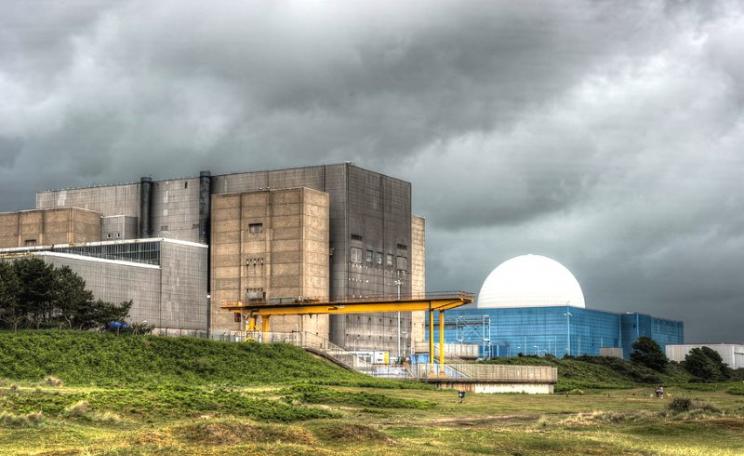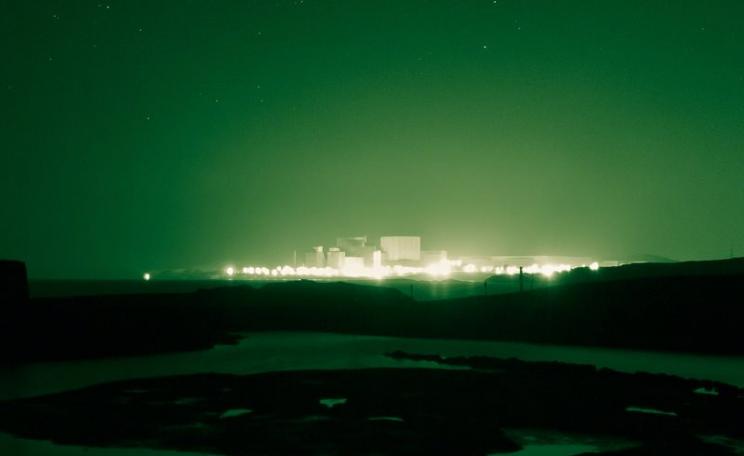Works not planned for include a new rail spur with workforce railway platforms, freight sidings, marine off-loading facility, an electricity sub-station, spent reactor fuel and nuclear waste stores and a visitor centre. Hence the dramatic expansion.
The Moorside nuclear project next to Sellafield in West Cumbria is big - very big. In the pipeline are three 'first of a kind' Westinghouse AP1000 reactors, each rated at 1,117MW.
in 2009 Nugen, the company that's set to build them, purchased a 200 hectare plot of land for the plant from the Nuclear Decommissioning Authority.
It was within this original land parcel that NuGen projected that "the most suitable 100 ha would be selected for the nuclear power station".
But the suite of public consultation documents Nugen launched in mid-May on its new-build plans exposed the need for significantly more land for the development than originally estimated.
It was a belated realisation that, given the topography, geology and other constraints of the Moorside site, the threee reactors plus all the associated paraphernalia needed to construct, operate and service them, were never going to be shoe-horned into original 100 ha.
So far, so bad. But now it just got a whole lot worse. NuGen's rethink of its land requirements is exposed on Page 22 of its Environmental Impact Assesssment Scoping Report Vol 1 with the statement that "the generating elements of the power station would cover some 200 hectares" - the whole of the originally purchased land area and not just 100 ha within it.
And that means all the other elements of the project will need even more land. As shown in Figures 1 & 2 (right), the knock-on effect is the dramatic expansion of the overall land area now required for investigation and development from 200 to 552 hectares - as also confirmed on the same page of the Scoping Report Vol 1.
The extent of Moorside's mission creep.
Figure 1 shows the Nominator Map originally published in the Government's 2011 National Policy Statement for Nuclear Power Generation (p.259) and from which some 200 hectares were purchased by NuGen from the Nuclear Decommissioning Authority (NDA) in 2009.
Figure 2 shows the new 552 hectare site rebranded as the 'Moorside Search Area' as identified in NuGen's Scoping Report Vol 2 (page 3) and within which the original 200 hectare land area, now identified as "boundary for reactors", has been transposed to illustrate the scale of expansion. The hatched areas on the map are defined as Initial Scoping Land and the grey areas as Additional Scoping Land.
Creeping ever northwards and westwards to the verges of the Beckermet (with its 11th Century St Bridgets Church, pictured) and Braystones villages, the (grey) Additional Scoping Land is described by NuGen as land in which "the siting and extent of proposed temporary and permanent works have yet to be confirmed."
Works not planned for include a new rail spur with workforce railway platforms, freight sidings, marine off-loading facility, an electricity sub-station, spent reactor fuel and nuclear waste stores and a visitor centre. Hence the dramatic expansion.
These temporary works - some or all of which could become permanent - include a new rail spur with workforce railway platforms, freight sidings, marine off-loading facility and other works. The permanent works - outside the boundary for reactors - will include amongst other developments an electricity sub-station, spent reactor fuel and nuclear waste stores and a visitor centre.
This sprawl of temporary and permanent facilities outside the rectors' boundary are likely to ruffle more than a few local feathers, particularly among property and land owners within the Additional Scoping Land who face the prospect of having their assets compulsorily purchased.
The US template that lies in store for West Cumbria.
Building three AP1000 reactors on a single site has never before been attempted by Westinghouse and some measure of the destructive sprawl awaiting the guinea-pig Moorside site and its local residents can be gauged from the photograph (above right) of the VC Summer site in South Carolina where just two AP1000 reactors are being built
The de-forested and bulldozed VC Summer construction site some five years after initial land clearance began. The new AP1000 reactor Units 2&3 (ringed) are seen at different stages of construction. Each reactor is made up of 200 plus modules which are assembled lego-style at assembly points around the site.
One such module, assembled from a number of sub-modules, weighed in at 1089 tonnes when it was craned into Unit 2 recently. An earlier non-modular Westinghouse PWR reactor (Unit 1 out of shot) which took nine years to build began operating in 1984.
The further sprawl receding into the background of the VC Summer site - adding considerably to the overall site size includes construction offices and equipment laydown and warehouse areas. At Moorside such facilities will be similarly located well outside the reactors' footprint and in the Additional Scoping Land shown in grey in Fig 2, bringing the overall new-build blight much closer to the bordering communities.
Cooling water for VC Summer's new reactors will be drawn from the local Monticello Reservoir with additional cooling provided by the circular low-profile (21 metre high) cooling towers - two per reactor - as seen on the far side of the site's perimeter.
In the consultation's Scoping Report Vol 1 (para 2.2.9) NuGen has ruled out for the use of large natural draught cooling towers of the type used for many existing coal fired power stations in the UK and confirmed its choice of direct seawater cooling for Moorside from the Irish Sea for which 2,000 hectares of offshore waters have been earmarked as the Indicative Marine Infrastructure Area - for cooling system sub-seabed tunnels etc.
Should additional cooling be required, the option of auxiliary cooling towers for Moorside - perhaps similar to those at VC Summer - is still under consideration by the developer.
All spin and no substance.
NuGen's apparent inability to estimate the land area required for Moorside is compounded by its wayward claim of a four-year build time for each of its projected AP1000 reactors and that, with reactor construction starting at yearly intervals from 2020, all three reactors would be producing electricity by 2026.
Such claims bear no resemblance to the current Westinghouse AP100 construction experience overseas. The VC Summer twin reactors pictured were also scheduled to be built in four years but are currently in their sixth and seventh years of construction respectively and still nowhere near completion or the production of electricity.
Similar delays are being incurred at the second site in the US and at both sites in China where Westinghouse is accused of overselling the system, overselling the technology and promising more than it could deliver.
The primary cause of the chronic construction over-runs overseas has been the continuing failure of the off-site fabricators to produce and deliver the major reactor modules to site on time or specification.
The cast iron inevitability that such quality assurance issues and delays will similarly plague Moorside, particularly as the key reactor components including pressure vessels, steam generators and containment domes must be imported from overseas, continues to be ignored by NuGen.
Similarly ignored is the logistical nightmare that awaits not only the import of such items but also the delivery of the hundreds of UK-produced modules through West Cumbria's chronically inferior road and rail infrastructure. The logistical bottle-neck to be faced in West Cumbria and the scale of overseas failures were explored in a CORE critique published in February 2015.
In the face of the incontrovertible overseas experience, NuGen's implausible plans and timescales and the misleading claims of Westinghouse strongly suggest that both have fallen into the trap of believing their own propaganda.
Clearly in good company, they join EDF and Areva whose humiliating new-build progress in France, Finland and at Hinkley Point in Somerset stands testament to the folly of pursuing an environmentally damaging technology whose sell-by date has long expired.
Martin Forwood is the Campaign Coordinator for anti-nuclear group CORE (Cumbrians Opposed to a Radioactive Environment) formed in 1980. He took up the position in 1989 and, with a focus on Sellafield's commercial operations, has represented CORE locally, nationally and internationally on a range of nuclear issues.
Petition: 'Stop Moorside: biggest nuclear development in Europe. To David Cameron and the Leaders of Europe' (38 Degrees).
Also on The Ecologist: 'Nugen's AP1000 nuclear reactor - is it any better than the EPR?'
More information: Radiation FRee Lakeland.






